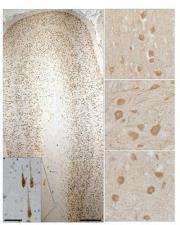Rare disease in Amish children sheds light on common neurological disorders

So often the rare informs the common. Penn researchers investigating a regulatory protein involved in a rare genetic disease have shown that it may be related to epileptic and autistic symptoms in other more common neurological disorders.
A team of researchers from the University of Pennsylvania School of Medicine, led by Peter B. Crino, MD, PhD, associate professor of Neurology and director of the Penn Epilepsy Center, demonstrate how mutations in the STRAD-alpha gene can cause a disease called PMSE (polyhydramnios, megalencephaly, and symptomatic epilepsy) syndrome, found in a handful of Amish children. PMSE is characterized by an abnormally large brain, cognitive disability, and severe, treatment-resistant epilepsy.
Specifically, in an animal model, they found that the lack of the STRAD-alpha protein due to genetic mutations causes activation of the signaling pathway involving another protein called mTOR. In humans, this in turn may promote abnormal cell growth and cognitive problems in the developing brains of children. STRAD-alpha and mTOR proteins are part of a complex molecular network implicated in other, more common neurological disorders, many of which have autism-like symptoms as a component.
"The identification of a new gene that regulates mTOR provides fascinating insights into how mTOR pathway dysfunction may be associated with neurological disorders," says Crino. "Each new mTOR regulatory protein that is identified provides a new possible therapeutic target for drug development and treatment."
The research on PMSE - published this month in the Journal of Clinical Investigation - reveals clues about more common neurological disorders characterized by benign tumors and malformations of the brain, the most common of which is tuberous sclerosis complex (TSC). The root cause of TSC also lies in mutations in proteins along the mTOR pathway, however a different protein is affected compared to PMSE.
"It is quite compelling that TSC, a relatively common disorder, and PMSE, a rare disorder, are linked by a common cellular pathway, and exhibit similar severe neurological features," notes Crino. "In our study, we found that we could reverse some of the cellular features that result from STRAD-alpha deficiency in cell culture models of PMSE. This provides important conceptual support for more widespread treatment approaches that modify mTOR signaling in neurological disorders associated with epilepsy, autism, and cognitive disability."
Current estimates place tuberous sclerosis complex-affected births at one in 6,000. Nearly 1 million people worldwide are known to have TSC, with approximately 50,000 in the United States.
PMSE, on the other had, has only been described in 25 people in Lancaster County, PA. It's incidence among other Amish populations, let alone the rest of the country, is unknown. PMSE is also known as pretzel syndrome in the Amish community, because the lax joints of patients fold over easily. PMSE was identified in an Amish, or Old Order Mennonite pediatric population in 2007 by researchers from Penn and the Clinic for Special Children in Lancaster, PA, a genetic clinic devoted to the needs of the Amish.
The mTOR pathway normally controls cell growth, but in PMSE uncontrolled mTOR signaling leads to increases in brain size and areas in which the cerebral cortex is malformed. To prove this, the researchers knocked down the activity of the STRAD-alpha protein in a mouse model and caused malformations of the developing brain. The structure of these malformations was similar to what is seen in human PMSE and TSC and supports the conclusion that normal brain development in part depends on normal STRAD-alpha function. Localized brain malformations are among the most common causes of epilepsy and neurological disability in children.















